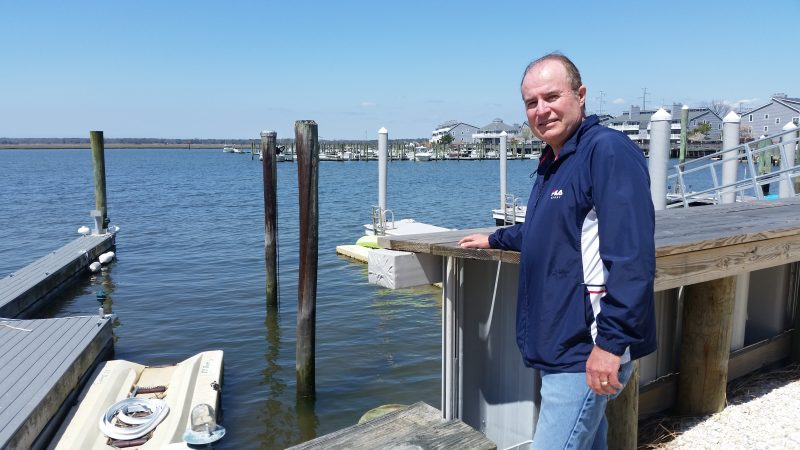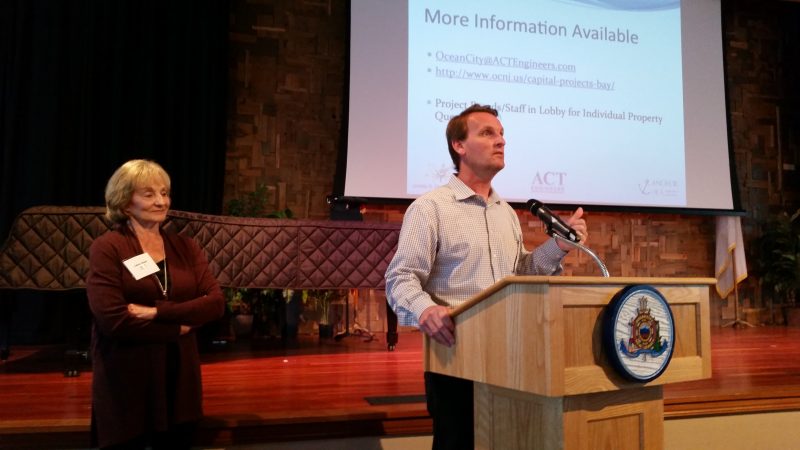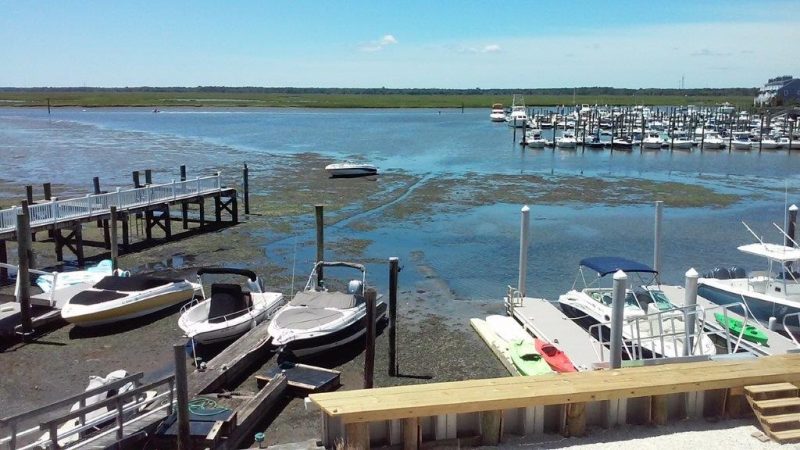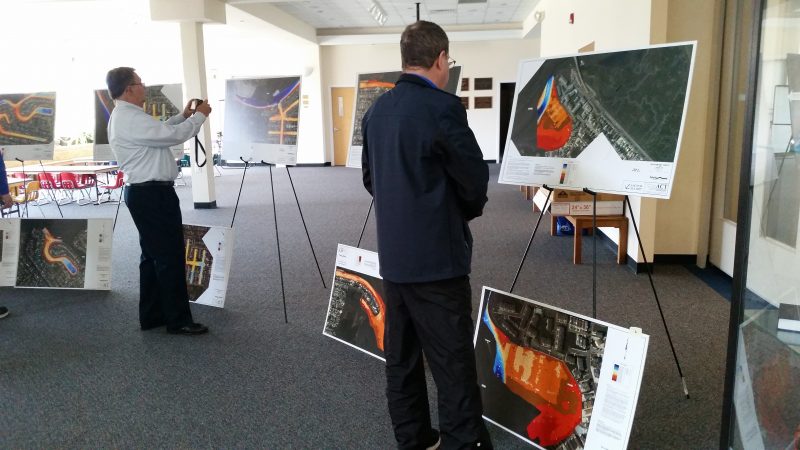Residents scrutinize maps and renderings of the proposed areas that will be dredged during the 2018-2019 program.
 By Donald Wittkowski
Rich Stahler, a resident of Waterview Boulevard, recalled a terrifying incident in 2000 in which one of his neighbors slipped off his boat dock and fell into the lagoon.
“It took six of us to get him out,” Stahler said of the rescue effort.
The man wasn’t in danger of drowning. Instead, he sank chest-deep into the muck and mire of the Waterview Boulevard lagoon and had to be hauled out.
The sediment-choked Waterview lagoon is emblematic of other shallow and treacherous channels lining Ocean City’s back bays. However, bayfront residents are about to get some relief as part of the next round of the city’s dredging program to deepen the lagoons and channels.
Ocean City has become the first municipality in New Jersey to receive a state permit allowing it to dredge along the entire length of the barrier island, officials announced Saturday during a town hall meeting attended by about 100 residents.
“Let me say that this was no small feat,” said Carol Beske, founder of ACT Engineers Inc., the city’s dredging consultant. “When we first proposed this idea, we were told that it’s never been done.”
The permit from the New Jersey Department of Environmental Protection essentially gives the city blanket approval to dredge the bayfront from one end of town to the other. In the past, the city had to secure permits for each dredging project it had proposed.
Next, the city must secure a similar island-wide permit from the U.S. Army Corps of Engineers, a federal agency that oversees dredging projects. Beske said the federal permit is expected to be approved, too.
With both permits in hand, the city will launch its 2018-2019 dredging program on July 1. The annual dredging season runs from July 1 to Feb. 28 under the regulatory guidelines.
During the town hall meeting at the Ocean City Tabernacle, Beske also announced the bayfront areas that will be dredged as part of the 2018-2019 program. The areas with the most severe problems will be done first. The entire list is available online at www.ocnj.us/capital-projects-bay/.
By Donald Wittkowski
Rich Stahler, a resident of Waterview Boulevard, recalled a terrifying incident in 2000 in which one of his neighbors slipped off his boat dock and fell into the lagoon.
“It took six of us to get him out,” Stahler said of the rescue effort.
The man wasn’t in danger of drowning. Instead, he sank chest-deep into the muck and mire of the Waterview Boulevard lagoon and had to be hauled out.
The sediment-choked Waterview lagoon is emblematic of other shallow and treacherous channels lining Ocean City’s back bays. However, bayfront residents are about to get some relief as part of the next round of the city’s dredging program to deepen the lagoons and channels.
Ocean City has become the first municipality in New Jersey to receive a state permit allowing it to dredge along the entire length of the barrier island, officials announced Saturday during a town hall meeting attended by about 100 residents.
“Let me say that this was no small feat,” said Carol Beske, founder of ACT Engineers Inc., the city’s dredging consultant. “When we first proposed this idea, we were told that it’s never been done.”
The permit from the New Jersey Department of Environmental Protection essentially gives the city blanket approval to dredge the bayfront from one end of town to the other. In the past, the city had to secure permits for each dredging project it had proposed.
Next, the city must secure a similar island-wide permit from the U.S. Army Corps of Engineers, a federal agency that oversees dredging projects. Beske said the federal permit is expected to be approved, too.
With both permits in hand, the city will launch its 2018-2019 dredging program on July 1. The annual dredging season runs from July 1 to Feb. 28 under the regulatory guidelines.
During the town hall meeting at the Ocean City Tabernacle, Beske also announced the bayfront areas that will be dredged as part of the 2018-2019 program. The areas with the most severe problems will be done first. The entire list is available online at www.ocnj.us/capital-projects-bay/.
 Mayor Jay Gillian explains the dredging program to the audience while Carol Beske of the ACT Engineers Inc. consulting firm looks on.
Mayor Jay Gillian told the audience during the meeting that the city is aggressively moving forward with the dredging program. It will protect property values, improve safety and help the boat owners, he pointed out.
“We are doing everything we can,” Gillian said.
Mayor Jay Gillian explains the dredging program to the audience while Carol Beske of the ACT Engineers Inc. consulting firm looks on.
Mayor Jay Gillian told the audience during the meeting that the city is aggressively moving forward with the dredging program. It will protect property values, improve safety and help the boat owners, he pointed out.
“We are doing everything we can,” Gillian said.
 The Waterview Boulevard lagoon resembles a mud flat during low tide. (Courtesy Rich Stahler)
Stahler was pleased to hear Waterview Boulevard will be a high priority in the 2018-2019 dredging program. He said he can only get his boat out on the water during high tide. Once he’s on the open water, he must wait for high tide again to travel across the lagoon back to his house.
“If it’s not high tide, you’re stuck. You have to stay out. You cannot get back in,” he said in an interview at his home.
Stahler was among the homeowners who attended the town hall meeting. Other residents living along the shallow back bays complained that they are trapped at their boat slips or only have access to the waterways during high tide.
“Our dock gets completely dry,” said Woody Howell, who lives at 11th Street and Bay Avenue.
Howell and his wife, Barbara, bought their bayfront home last year. They like to ride Jet Skis on the bay, but have to wait until high tide for enough water to navigate through their lagoon.
“If you head out on the water and are not aware of when high tide goes in and out, you literally get stuck out there and are not able to get back in,” Howell said.
Also at Saturday’s meeting, city officials reminded homeowners of a voluntary program that allows them to piggyback on the town’s regulatory permits to dredge their own boat slips. Homeowners would still have to pay for dredging their slips, but the plan relieves them of some of the costs and headaches of doing the work on their own, including finding a disposal site for their dredge spoils.
Ocean City’s multifaceted dredging program is being touted as a model for all New Jersey shore towns that are dealing with the dangerous problem of sediment-choked waterways, Beske said.
The Waterview Boulevard lagoon resembles a mud flat during low tide. (Courtesy Rich Stahler)
Stahler was pleased to hear Waterview Boulevard will be a high priority in the 2018-2019 dredging program. He said he can only get his boat out on the water during high tide. Once he’s on the open water, he must wait for high tide again to travel across the lagoon back to his house.
“If it’s not high tide, you’re stuck. You have to stay out. You cannot get back in,” he said in an interview at his home.
Stahler was among the homeowners who attended the town hall meeting. Other residents living along the shallow back bays complained that they are trapped at their boat slips or only have access to the waterways during high tide.
“Our dock gets completely dry,” said Woody Howell, who lives at 11th Street and Bay Avenue.
Howell and his wife, Barbara, bought their bayfront home last year. They like to ride Jet Skis on the bay, but have to wait until high tide for enough water to navigate through their lagoon.
“If you head out on the water and are not aware of when high tide goes in and out, you literally get stuck out there and are not able to get back in,” Howell said.
Also at Saturday’s meeting, city officials reminded homeowners of a voluntary program that allows them to piggyback on the town’s regulatory permits to dredge their own boat slips. Homeowners would still have to pay for dredging their slips, but the plan relieves them of some of the costs and headaches of doing the work on their own, including finding a disposal site for their dredge spoils.
Ocean City’s multifaceted dredging program is being touted as a model for all New Jersey shore towns that are dealing with the dangerous problem of sediment-choked waterways, Beske said.
 Residents scrutinize maps and renderings of the proposed areas that will be dredged during the 2018-2019 program.
Residents scrutinize maps and renderings of the proposed areas that will be dredged during the 2018-2019 program.